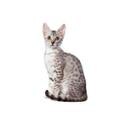Egyptian Mau Cat

The Egyptian Mau is fiercely devoted to her humans and vocally shows signs of happiness and affection by meowing in a pleasant voice. She’ll also slowly swish her tail and knead with her front paws. She loves to display her hunting skills by chasing and retrieving a toy. As a moderate- to highly active breed, you may find her on top of your refrigerator or bookshelves.
Egyptian Maus also love playing with water and are smart enough to learn how to turn on the faucet. Despite her high energy levels, she adores curling up in your lap for a snuggle session. She’s great with playful children and other cat-friendly pets who can keep up with her active and energetic lifestyle, though reserved and wary around unfamiliar guests.
Each cat breed has distinct characteristics that influence its exercise, dietary, and health needs. Understanding your cat’s breed-specific traits is essential for providing proper care and ensuring their well-being. Whether it’s a high-energy breed that requires more physical activity or a smaller breed that thrives with less exercise, knowing these needs helps you make informed decisions. By tailoring your cat’s routine to their specific breed, you’ll help them live a longer, happier, and healthier life.